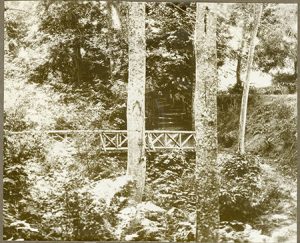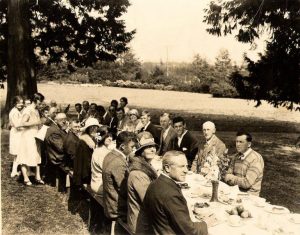PARK HISTORY
| Dominion Brook Park is a unique 11 acre park on the Saanich Peninsula created by the Canadian Department of Agriculture as a public demonstration arboretum and ornamental garden. The land was cleared in 1912 and immediately readied for planting under the direction of W.T. Macoun, Dominion Horticulturist, son of the world famous botanist, John Macoun.
Plant material was ordered from well known nurseries in Britain, France, Holland, Germany, Japan and the USA. Documents record delivery of a shipment of 60 different rhododendrons and ornamentals from the Arnold Arboretum at Harvard University which included rhododendrons and other species grown from seed collected in Western China by renowned plant hunter, Ernest “Chinese” Wilson. There are survivors from this original planting. |
 |
Of the hundreds of species planted over the last 104 years, many have not survived but an amazing number have grown to maturity. Our pride and joy is the collection of mature conifers.
The Society is fortunate in having detailed records including the original 1913-14 invoices which have revealed fascinating details about individual trees and shrubs.Not only were the plant selections exciting, the layout of the Park was masterly landscaped in the extensive variation of terrain which combines glades, dells and vistas with ponds and pools with extensive stonework and of course, Dominion Brook.
During the years when DBP was meticulously maintained by Experimental Farm staff, the Park was a popular place for family and community events and as such, played an important role in the social history of the Peninsula. When federal funding for maintenance ceased in the early 1980s, the unique plantings began to disappear under ivy and blackberry.
 |
Fortunately, in the late 1990s a citizens group spearheaded by John and Katie Dawson led to the formation in 2000 of a volunteer non-profit society, “Friends of Dominion Brook Park Society” which now has just under 100 members. A grant from the Provincial Capital Commission, through its former Greenways Program allowed the Park to be fenced for public use. |
This in turn enabled the District of North Saanich to negotiate a stewardship agreement with the Federal Government and the Friends of Dominion Brook Park with a 5/5 year lease. In July, 2009, a renegotiated lease for 25 years with an option for a further 25 years was signed between the Federal Government and the District of North Saanich.
This cooperative effort between citizens, municipality and federal governments has led to an extraordinary rebirth of the old Park. Since fieldwork began in 2001 volunteers have contributed over 10,000 hours of clean up and rehabilitation work along with the assistance of the District of North Saanich and Centre for Plant Health (formerly Dominion Experimental Farm) The volunteer work has progressed to the point of allowing the Society to begin planting programs to enhance the remaining material. A Plant Acquisition Fund has been established to help with this project. A recent accomplishment is the restoration of the formerly magnificent Rhodo Ravine where Dominion Brook meanders through the Park.
Dominion Brook Park has been part of Peninsula history from its inception when the B.C. Electric Railway stopped at the bottom of the Park and brought large groups for picnics and holiday outings. Today, the Park’s popularity continues to grow with visitors and groups as diverse as the Westie Walk, weddings, school outings, family gatherings, geocaching, and Easter Egg Hunts. Dogs are welcome but it is mandatory to clean up after your pet. Unleashed pets are restricted from entering the Sunken Garden (Sam’s Garden) so we may protect the plantings as we continue to restore the area.
You are invited to hold social functions such as group picnics, club outings, family celebrations in this lovely oasis in North Saanich. Contact: parksinfo@northsaanich.ca.
The Friends of Dominion Brook Park welcomes volunteers with or without gardening experience for help in the many related tasks connected to rehabilitation of the Park. The ‘hands on’ volunteers meet on Wednesday, 9 – 11 a.m. weather permitting from March to October. If you are interested in supporting the restoration of this horticultural treasure please contact us.